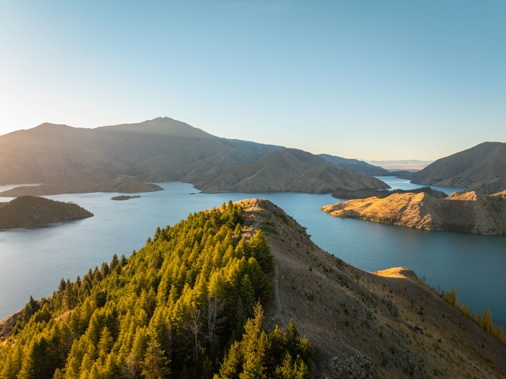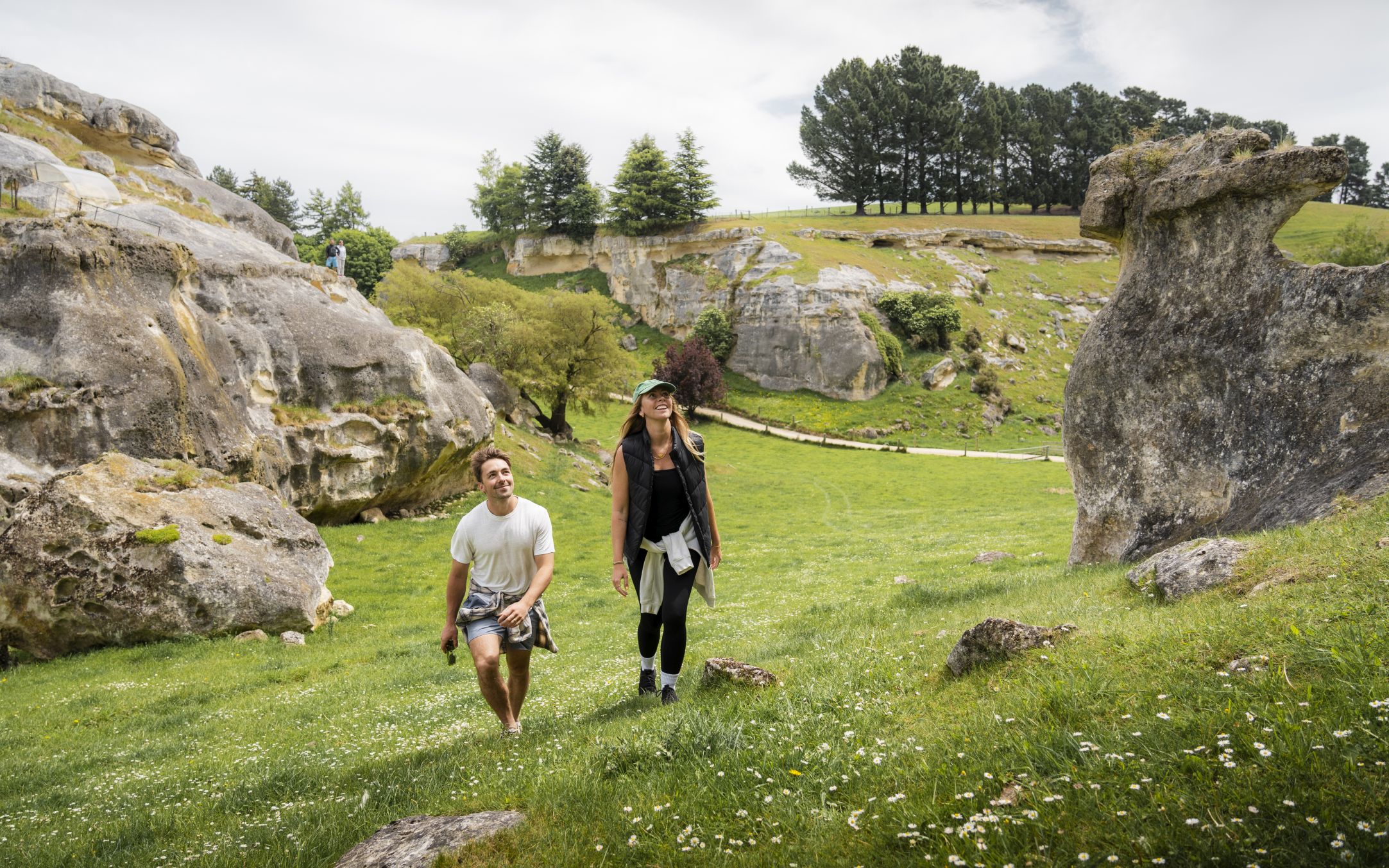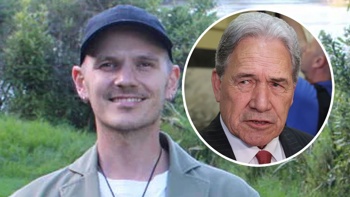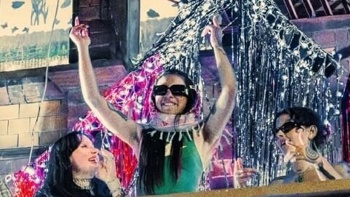
The wonderful Waitaki district sure knows how to wow. Whether neo-classical Victorian streetscapes, ancient Māori rock art, limestone formations, penguin parades or Steampunk is your bag, it’s a region ripe with riches. But before savouring the manifolds delights of Ōamaru, I headed west, into the Waitaki Valley, where the raffish charm of Duntroon is the launch pad into the Waitaki Whitestone Geopark. As New Zealand's first and only UNESCO Global Geopark, it threads together the spell-binding natural landforms, abundant fossil finds and rich cultural history of the Waitaki Valley, which was under sea when Zealandia drifted away from Gondwana. www.whitestonegeopark.co.nz
Seismic forces later thrust the ancient seabed upwards, at the same time the Southern Alps were formed. Robert Campbell, the wealthy land-owner and runholder established Duntroon in 1864, naming it in honour of his Scottish birthplace. This cute-as-a-button village is home to the Vanished World Centre, but before heading there, don’t miss Duntroon’s assorted trove of evocative landmarks. St Martin’s Church is Christmas Card perfect, a lustrous limestone church, funded by the Campbell family. A flock of sheep suitably adorn and tend to the church grounds. On the highway roadside, step inside the 115 year old Duntroon Gaol for an indelible sense of the frigid confines of old-school incarceration.
Directly across the road, I was guided through the rustic charm-factory of Nicol’s Blacksmith, one of the few operating blacksmith shops left in New Zealand. It’s irresistibly authentic, with the forge fired up on weekends and beginner blacksmithing courses still held, if you want to try your hand at ironwork. Wattie Yardley, who migrated to New Zealand in the 1890s from the Orkney Islands, first owned and operated the smithy. It soon became the community hub, as locals swapped stories over horseshoes. Tragically he was killed in a road crash in 1930, shortly after selling the smithy to Nicol Muirden, whose name still adorns the property today.

Roady NZ.
25 million years ago, the land around Duntroon was the ocean floor. And over the ages, fossil fragments from the marine life of the time, settled on the seafloor, 75-100 m below the sea surface. The magnificent Vanished World Centre brings to life the pre-historic wealth of the region. It’s a scene-setter and a trophy-room that speaks to the geological wonderland bestowed on the Waitaki District. I marvelled over the displays of prehistoric dolphin skulls, whale and penguin bones, unearthed by local farmers from the limestone. All manner of discoveries have been found lodged in the region’s famous limestone, which was created by broken down ancient marine life.
After getting to grips with the barebones geological back-story, free-roam the region on the Vanished World Trail and explore some of the 40 designated sites of significance that comprise the geopark. There’s a great self-drive touring route. The karst landscape and its whitestone are at the core of Waitaki’s identity. I called into Takiroa, the rock art site where ancient Māori, travelling through the Waitaki Valley for food-gathering, found shelter in the limestone overhangs, etching images of animals and early European contact into the cliff face. Elephant Rocks is a wonderfully whimsical affair, where towering limestone rocks have been sculpted and eroded by wind and water to form elephant-shaped outcrops. The site was used in the filming of The Lion, The Witch and The Wardrobe.
Nearby, at Anatini, the fossilised bones of a baleen whale have been exposed in the limestone, which also served as the setting as Aslan’s Camp in the Narnia film trilogy. The wider Awamoko Valley is dubbed the Valley of the Whales in deference to the abundance of fossilised marine life. Another awe-inspiring spectacle is strikingly called Waipata/Earthquakes, where monstrous slabs of limestone
have splintered off the hillside when the land slumped thousands of years ago. It’s still a high rock-fall risk area -so be cautious. But it’s not just limestone that holds court in this geopark, volcanic cones and mesas rising above the rolling downs. Ōamaru itself is built on a long extinct volcano. Also on the trail, there’s the Moeraki Boulders, and Ōmarama’s pinnacled Clay Cliffs, 45 minutes further west from Duntroon.

Tourism Waitaki.
Don’t you love coming across something so unexpected and unusual, on a road-trip? That’s how most visitors feel when they first clap eyes on the bewitching glory and striking landforms of the Paritea Clay Cliffs. It’s one of the most popular geo-sites in the Waitaki Whitestone Geopark, just minutes from Ōmarama, on Henburn Road. It is absolutely worth the 15 minute diversion off the main road to savour this serrated geological wonder, complete with a slot canyon to shimmy through. It feels like a mix of Utah and Petra as you size up the fluted shapes of the tall columns and the beautiful pastel colours. They are a grand collection of ‘bad land’ sharp pinnacles and ridges separated by steep and narrow ravines, reminiscent of giant organ pipes, of varying sizes, thrusting up from the eroded cliff face.
The landmark was created out of layers of silt and gravel deposited by ancient lakes and rivers around 20 million years ago. They have since been uplifted and tilted by the nearby active Ostler Fault, and eroded. The cliffs are on private land and there is an honesty box at the gate where you are asked to pay $5 per car. After passing through the gate, drive to the carpark. From here you can walk up to and among the cliffs (10-15 mins from carpark one way). The road and track can get a little rough after rain– and inside the cliffs’ slot canyon, those rocks do get slippery underfoot. Closed, sturdy footwear is advised.
If you’re tracking back to Ōamaru from Ōmarama, dabble in the delights of the Waitaki Valley’s Lakes District, studded with hydro stations. Lake Benmore is New Zealand’s largest artificial lake, created by the Benmore Hydro-Dam. It was completed in 1965 and at the time was New Zealand’s biggest ever construction project. It remains our largest rammed earth dam. The lake holds about 1.25 billion cubic meters of water, which is roughly 1.5 times the water in Wellington Harbour! With its vivid blue colour and breathtaking hill country views, Lake Benmore is a peaceful haven, all year round.
Popular with boating and fishing enthusiasts, Benmore also boasts fantastic walking and cycling trails. I highly recommend the Benmore Peninsula Track, a 4km loop walk just up the hill, for dreamy views down on the lake, while Mt Cook shimmers in the distance. Do it early in the morning, when the weather is typically calm. Pumpkin Point is a stunningly scenic spot on Lake Benmore to roll out the picnic rug.
The Waitaki Valley’s exploits in viticulture is attracting attention with over a dozen vineyards in operation. Throughout the valley, seams of limestone provide the ideal foundation for producing Burgundy-style wines. The first vines were planted at the turn of the millennium and the limestone rich soils, combined with the arid climate give rise to delicate tones. Pinot Noir is the signature variety, alongside Pinot Gris and Riesling. River-T Wines is a small vineyard that was planted in 2007, and well worth a visit. They hand-harvest their grapes from April until mid-May, making it one of the last vineyards to harvest in New Zealand. The River-T Cellar door in Kurow has the largest selection of Waitaki Valley wines in the world. Not only stocking and tasting River-T but also some great wines from fellow producers in the valley. Finally, to metaphorically drink in the valley’s sweeping splendour, take the 45-minute climb up Kurow Hill walkway for panoramic views across the river to the Hakataramea Valley. I’ll raise a glass to that! www.waitakinz.com
Mike Yardley is our resident traveller on Jack Tame Saturday Mornings.
Take your Radio, Podcasts and Music with you









